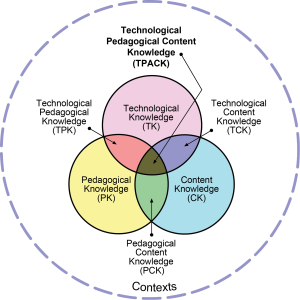Technological pedagogical and content knowledge (TPACK) incorporates teacher’s knowledge of the content area, how to teach that content, and which technologies to use to support that teaching method to result in learning. As Mishra and Koehler (2009) explain, “Teaching requires the transformation of content in ways that make it intellectually accessible to students” (p. 15). Technology provides this accessibility of the content to students as it can be interactive and engaging. For these students, technology can be an excellent tool for students to understand, learn about the content, and explore further.
Today in class, my partner Chris and I were given the simple task to create whipped cream. Sounds easy, right? Well not so simple when all we had to work with was a small bowl and a rubber spatula/spoon. First, Chris and I poured all the cream into the bowl, which we quickly realized was too small for all the liquid. After pouring some back into the container, I began to stir the liquid rapidly in the bowl for a few minutes. The cream started to foam a little bit, but no major transformation took place. Chris began to shake the remaining liquid in the carton. We both continued our jobs for a few minutes. My liquid was slowly thickening, and it seemed like it would be hours of stirring before I had real whipped cream. During this same time, Chris shook the carton continuously. In no time, he poured out beautiful, fluffy whipped cream onto the plate. I couldn’t believe he had made whipped cream already! We quickly realized that although I was using the technology made available (the rubber spatula and bowl), the carton proved to be more efficent and useful way to get to the end goal: whipped cream.
This situation resonated with me, as I currently teach at a school where a lot of technology is made available for student and classroom use. This forces me to think about how technology will aid students’ learning, or what changes I need to make to my teaching methods and the available technology to result in student growth. “The idea of creative repurposing is important because most technologies that teachers use typically have not been designed for educational purposes” (Mishra & Koehler, 2009, p. 16). A rubber spatula/spoon and a small bowl were not designed to specifically whip cream. I redesigned the rubber spatula/spoon to turn rapidly like a beater, which is not its intended purpose. Furthermore, this technology of beating the cream with the rubber spoon may have gotten the job done, but with more time than the “non-technology” route of shaking the container the cream was packaged in. In a similar sense, when redesigning technology for the classroom, I need to make sure it aligns well with both my pedagogy and the content being taught. If the technology will slow down the learning process or make the learning more frustrating for the student, I need to redesign that technology or use a different technology. I should not use technology for the sake of using technology. Chris did not use the intended technology and ended up with the whipped cream.
In addition, I need to focus on which technologies I should use to teach specific content. If we had a whisk or a hand mixer made available to Chris and me, we could have whipped the cream much faster and easier. “Each technology has affordances and constraints, potentials and problems that we as educators need to understand before we can start using them for pedagogical purposes” (Mishra & Koehler, 2009, p. 15). Before I bring new technology into the classroom, I need to play with it to assess whether it will be helpful or problematic to acquisition of content. Will technology be too confusing? Will it make the process of learning faster or slower? Will it help students engage with the material? Will it be frustrating to use and learn? I must consider all these questions before introducing or even reconstructing technology for the classroom. Using a rubber spatula/spoon and a small bowl was somewhat problematic, as it slowed down the process of making whipped cream more than using a hand mixer would have. In my classroom, I need to look over these situations and think whether my teaching would be improved by giving my students the hypothetical “rubber spoon” or the “electronic hand mixer” as their technology.
References:
Mishra, P. & Koehler. M. J. (2009). Too cool for school? No way! Using the TPACK framework: You can have your hot tools and teach with them, too. Learning & Leading with Technology, 36(7), 14-18.

It was a great idea to think about this topic from the standpoint of integrating technology that was not specifically designed for the classroom into the classroom. I think one of the biggest problems is finding the time to try the new technology. Another big problem with the new technology is keeping up with everything, so you can keep trying to integrate the new technology into educational technology. You almost have to enter your classroom with a mindset of constantly changing your lessons to incorporate new ideas that will help your students learn.
I like the picture of TPACK and good definition of it. Good connection of re-purposing technology but also thinking about if it was effect and beneficial re-purposing. Good recognition of critical questions you need to think about and ask yourself about the technology you are using and if the re-purposing is meaningful.